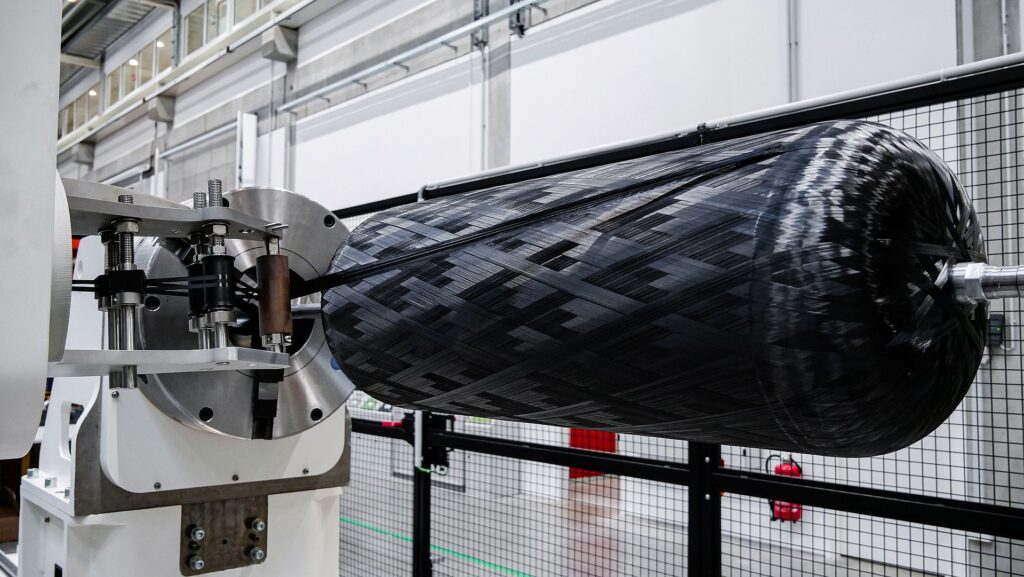
Carbon fiber, a material once reserved for high-performance automotive and aerospace applications, is now making waves in the space industry. The start-up Blackwave, founded at the Technical University of Munich (TUM), is at the forefront of this transformation, evolving from crafting custom components for sports cars and aircraft to pioneering high-pressure tanks for rockets.
Blackwave’s journey highlights a critical engineering challenge: maintaining structural integrity in rockets as they consume fuel. Traditionally, rockets lose stability when their fuel tanks, known as primary tanks, empty during flight. To counter this, engineers use secondary high-pressure tanks filled with noble gases to occupy the empty space, ensuring the rocket’s structure remains intact.
As Bastian Behrens, founder of Blackwave and TUM alumnus, explains,
“It’s like a can of soda – the ratio of wall thickness to diameter is actually quite similar in aerospace. As long as the can is filled with liquid and CO₂, I can stand on it without worry. But once it’s empty, it immediately loses its structural integrity.”
Revolutionizing High-Pressure Tanks
Traditionally, these high-pressure tanks were made from heavy steel and exclusively in spherical forms to withstand extreme conditions, including pressures up to 420 bar and temperature fluctuations from minus 50 to plus 120 degrees Celsius. However, Blackwave has developed a groundbreaking solution: high-pressure tanks made from carbon fibers.
Since 2018, Blackwave has been producing these carbon fiber tanks, which offer several advantages. Carbon fibers are not only strong and ideal for high-pressure applications but also chemically inert, making them suitable for use with aggressive fuels. Moreover, carbon tanks are significantly lighter and more flexible, allowing for easier integration into fuel systems compared to their steel counterparts.
The innovation has attracted significant interest from renowned aerospace companies in Europe and the U.S. Behrens notes,
“The tank is the most elegant application we know today for carbon fibers. The stresses in tanks are purely tensile – and if carbon fibers excel at one thing, it’s handling tensile stress.”
From Passion to Innovation
Bastian Behrens’ fascination with carbon fiber began in his school days, where he crafted carbon parts for his motorcycle. His academic journey led him to TUM, where he joined the TUM Student Club TUfast, developing carbon components for the racing team. This experience laid the foundation for Blackwave.
Behrens’ passion for high-performance engineering and space exploration, fueled by his love for franchises like Star Wars and Star Trek, guided his path from automotive to aerospace industries. The transition from student projects to a full-fledged company was facilitated by TUM’s robust support network.
The Role of TUM’s Innovation Ecosystem
Blackwave’s success story is intertwined with TUM’s innovation ecosystem, one of Europe’s most successful deep-tech hubs. TUM and UnternehmerTUM, the Center for Innovation and Entrepreneurship, provide tailored support to start-ups, offering access to cutting-edge research, technical infrastructure, and market expertise.
In recent years, TUM has supported over 1,100 start-up teams, with UnternehmerTUM investing through its venture capital fund. This ecosystem fosters collaboration between start-ups, established companies, experts, and investors, creating a fertile ground for innovation.
Today, Blackwave employs nearly 100 people and sells its products globally. Some of their products have already achieved “flight heritage,” meaning they have been successfully deployed in space. This milestone underscores Blackwave’s impact on the aerospace industry and the potential of carbon fiber technology.
The evolution of Blackwave from a student project to a key player in the aerospace industry exemplifies the transformative power of innovation and collaboration. As the demand for lightweight, durable materials in space exploration continues to grow, Blackwave’s carbon fiber tanks are poised to play a crucial role in the future of aerospace technology.






